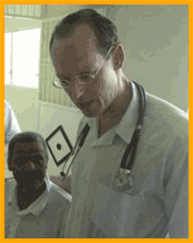The year he co-founded Partners In Health, Paul Farmer was twenty-six years old. By age twenty-six, he had already studied at two of America's greatest institutions, treated patients in Haiti, and helped to set up an organization that would one day become one of the most important players in international health. However, the accomplishements to follow would be even more impressive. In 1993, Farmer was awarded the John D. and Catherine T. McArthur "Genius" grant, which he used to establish PIH's research division, the Institute for Health and Social Justice. But as great an honor his MacArthur was, Farmer was discouraged.

Paul Farmer speaking to his patients in Haiti. |
After Francois Duvalier's reign, Haiti was, in effect, ruled by the Haitian army. At the same time, a new figure arose in Haitian politics. A charismatic Catholic priest named Jean-Bertrand Aristide was rapidly gaining popularity for his speeches about resisting abuse, repression, and poverty. Excited to hear about ideals so similar to his own, Farmer soon became an admirer of Aristide, and before long, the two men became friends. Unfortunately, this relationship caused problems for Farmer. After Aristide's victory in the 1990 election, Farmer returned to Boston. When Aristide was deposed by the Haitian army in the fall of 1991, Farmer was blacklisted and not allowed to return to Haiti. A few years before, Partners In Health had built its first women's health clinic in the central plateau. PIH had also built schools and set up trainings for community health workers. Farmer longed to see his patients and was miserable until he was removed from the blacklist. He returned to Haiti as soon as he could.
A year later, PIH took on another project, this time in Carabayllo, a town close to Lima, Peru. A crowded slum with no sewage system, Carabayllo was a town in which disease, particularly tuberculosis (TB), could spread quickly. PIH was dismayed to discover a strain of multidrug-resistant tuberculosis (MDR-TB). They had not encountered many MDR cases in Haiti, which was fortunate because it was expensive to treat and required several rounds of drugs. Patients developed MDR when placed on a medication, but failed, for whatever reason, take it regularly. This would lead to the prescription of more drugs and the development of the same negligence caused immunity, until the patient grew resistant to all of them. By that time, the disease would be extremely expensive to treat and the medicine could have dangerous side effects. Jim Yong Kim, Paul Farmer, and Jaime Bayona, the project director at PIH's newest site, Socios en Salud, decided that they would begin treating patients anyway. Despite the skepticism of the Peruvian government as well as that of many scholars and doctors, PIH's MDR treatment program was a great success. In 1998, after two years of treatment, it was reported that 85% of patients had been cured. Reluctantly, the World Health Organization began to accept Kim and Farmer's methods of treatment, and appointed them to lead several pilot MDR-TB programs.
A similar case of MDR-TB was soon brought to attention half way around the globe. MDR had become a growing issue in Russian prisons. Crowded cells and poor TB treatment allowed the disease to transmit quickly. Some prisoners even survived long enough to be released and spread MDR to the outside world. In 2001, PIH took over responsibility for clinical care in Tomsk, Siberia. Treatment is still ongoing today with very promising results.
In 2005, Paul Farmer and PIH extended their reach to Africa, where they now have clinics and programs in Rwanda, Malawi, and Lesotho. It may be difficult to imagine what Farmer and his colleagues planned for PIH twenty years ago, but as founding partner Tom White says, it's really quite simple: "We never put any limits on where we'd go. We just went as fast as we could and went as many places as we could...and I know right now that we'll never stop..."

